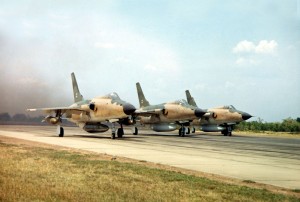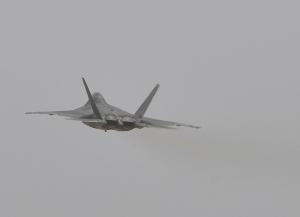F-105 Fighter-Bombers Take Off on Mission to Strike North Vietnam in 1966 (USAF Photo)
A half-century ago, the United States was into the fifth month of the longest sustained strategic bombing campaign this nation has ever conducted, Operation Rolling Thunder, an attempt to thwart an insurgency with air power by attacking the external power that backed it with men and equipment. To today’s readers, parallels between American bombing efforts in 1965 against Viet Cong insurgents and the North Vietnamese who supported them to current bombing efforts against ISIL in Syria, and most especially, in Iraq, may seem obvious, but many differences also exist.
For instance, by the end of 1965, 180,000 American troops were in South Vietnam, and when Rolling Thunder ended on 1 November 1968, that total had climbed to more than 500,000. In addition, American advisors helped train a vast South Vietnamese Army, known as the ARVN, or Army of the Republic of Vietnam, which numbered 1,000,000 troops when the North Vietnamese Army launched a massive, 120,000-man conventional assault, complete with T-54 tanks and heavily artillery, on the South at the end of March 1972. Despite the ARVN’s vast numerical advantages and extensive amounts of American training, had it not been for US air power, the NVA’s “Easter Offensive” would have destroyed the ARVN that year, and Saigon would have fallen three years earlier than it actually did. Indeed, when the ARVN did collapse in spring 1975, American air power was not present to bolster it. For those who bemoan the lack of adequate “friendly” ground forces in Iraq and Syria today, Vietnam shows that having a significant presence on the ground—either of American or indigenous forces—is no guarantee of success.
Another difference between the current conflict in the Middle East and Vietnam was the amount of American air power brought to bear. Rolling Thunder certainly started on a small scale, averaging only one or two raids a week for its first month because of President Lyndon Johnson’s concerns over possible active Chinese or Soviet intervention or deflecting attention away from his Great Society programs. Yet by June 1966 Johnson had unleashed part of his air power restraints and ordered the bombing of North Vietnamese oil storage areas around Hanoi and Haiphong in an effort to wreck truck-borne infiltration into South Vietnam. From the last week of June until the end of August, strike sortie allocation totals against North Vietnam jumped from an average of 8,100 sorties/month to 10,100/month, with norestriction on sorties launched against oil targets. In contrast, as Retired Lt Gen David Deptula notes in his 6 June 2015Washington Post op-ed, “Bombing Our Way to Victory,” almost one year after the US/Allied air campaign against ISIL began, that effort now averages 360 strikes sorties/month.
A further difference between Vietnam and today’s war in the Middle East is that, unlike the Viet Cong’s support from North Vietnam, ISIL has no direct benefactor for air power to target. Even though the VC insurgents needed a paltry amount of assistance from the North because of the infrequent guerrilla war that they waged, the US focused much of its air effort on stopping what commanders and political leaders alike believed was an essential supply flow coming from North Vietnam. ISIL remains functioning for many reasons: it receives funding from captured oil facilities, donations from wealthy backers, money from the sale of captured antiquities, a continual flow of men (and women) who support its cause and are willing to fight for it, and the tacit support of Sunni Muslims in Iraq who view ISIL as less oppressive than the Iraqi regime, which has endorsed sending Shiite militias, many of which are backed by Iran and exhibit ruthless behavior against Sunnis, to fight against ISIL. Those elements do not present clear-cut air power targets, and the best that bombing has done thus far is to kill ISIL leaders and troops when they gather in areas apart from the civilian populace. Yet ISIL has replaced many of its fallen leaders, and the infiltration/recruiting of new troops has made up for those eliminated by air power.
Moreover, as was the case in Vietnam, the collateral damage produced by air strikes in Iraq and Syria has received wide publicity, and ISIL has vastly more means at its disposal to publicize bombing mistakes than the North Vietnamese and Viet Cong possessed. Twitter, Facebook, Instagram, etc., etc., provide ISIL with instant means to highlight bombing “errors”—whether or not errors actually occurred. But—as was also true in Vietnam—perceptions can become reality, and can heighten—or serve as the basis of—the motivation to fight.
Perhaps the greatest similarity between Vietnam and the current clash against ISIL is the dominant role that perceptions have played in both conflicts. In South Vietnam, the bulk of the populace never trusted the Saigon regime, which was rife with corruption and deceit. What trust did exist faded more and more as the war progressed. In Iraq, the malfeasance of Nouri al-Maliki’s previous government caused many in the Sunni and Kurdish minorities to distrust it, and that foundation has proven difficult for many Sunnis and Kurds to overcome given that the current Iraqi government relies heavily on Shiite militias to prevent ISIL’s spread. Clausewitz noted that an enemy’s “power of resistance” equaled “the product of two inseparable factors, viz. the total means at his disposal and the strength of his will.” Air power, when unleashed the way it was in World War II, can do much to destroy the means to fight, but even then destroying enemy capability took a great deal of time. In wars such as Vietnam and the current struggle against ISIL, obliterating capability is not an option. Thus, much of the emphasis comes on destroying—or changing—will, and either is a devilishly tough prospect for air power to accomplish virtually alone—or even in tandem with other instruments of power. The year 2015 is not only the 50th anniversary of America’s large-scale combat involvement in Vietnam, but also marks the 40th anniversary of the fall of Saigon. Let’s hope that it does not become a marker toward a similar outcome in the Middle East as well.






